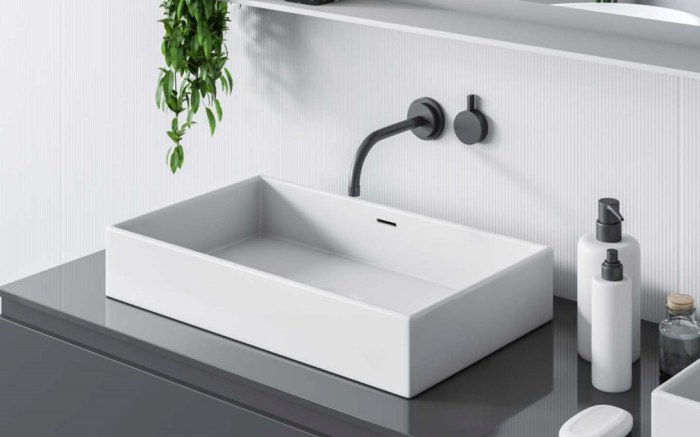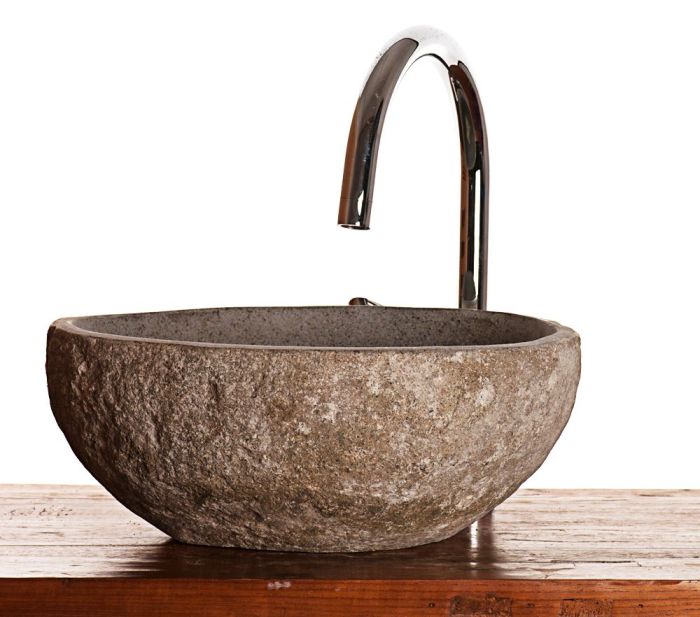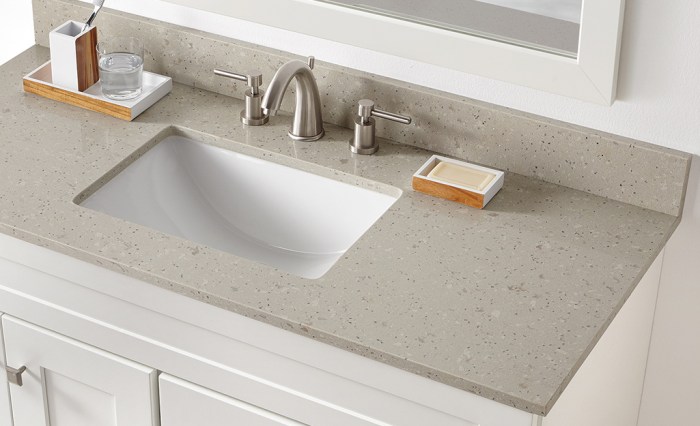In the realm of bathroom design, tradition has long dictated the use of porcelain or ceramic for bathroom sinks. However, in recent years, a wave of innovation has swept through the industry, introducing a plethora of non-traditional materials that are revolutionizing the way we think about bathroom sinks.
These non-traditional materials offer a myriad of advantages, from enhanced durability and ease of maintenance to stunning aesthetics. They also allow for a wider range of design possibilities, enabling homeowners to create truly unique and personalized bathroom spaces.
Non-Traditional Materials for Bathroom Sinks
Bathrooms have traditionally been adorned with ceramic or porcelain sinks. However, the realm of bathroom design has expanded, introducing an array of non-traditional materials that offer unique aesthetics and functional advantages.
These materials break away from conventional norms, providing homeowners with a wider spectrum of options to customize their bathroom spaces. From the durability of concrete to the warmth of wood, these non-traditional materials elevate bathroom design to new heights.
Concrete
Concrete, once relegated to structural applications, has emerged as a captivating choice for bathroom sinks. Its inherent strength and versatility make it an ideal material for creating durable and visually striking fixtures.
Concrete sinks can be molded into various shapes and sizes, allowing for customization to suit any bathroom layout. Their matte finish adds a touch of industrial chic, while their resistance to heat and chemicals ensures longevity.
Wood
Wood, known for its warmth and natural beauty, brings an organic element to bathroom design. Wooden sinks are often crafted from sustainable sources, such as reclaimed wood or bamboo, adding an eco-friendly touch to the space.
The rich grain patterns and unique textures of wood create a sense of coziness and warmth. Wooden sinks are naturally water-resistant, but require proper sealing and maintenance to preserve their integrity.
Advantages and Disadvantages of Non-Traditional Materials
Non-traditional materials for bathroom sinks offer unique advantages and disadvantages compared to traditional materials like ceramic or porcelain. Understanding these factors can help you make an informed decision for your bathroom renovation.
Durability
Non-traditional materials vary in durability. Some, like acrylic and solid surface materials, are highly durable and resistant to scratches and stains. Others, such as glass and concrete, may be more prone to damage or require special care. Consider the intended use and traffic in your bathroom when choosing a material.
Maintenance
Maintenance requirements can also vary depending on the material. Acrylic and solid surface sinks are generally low-maintenance, requiring only regular cleaning with mild detergents. Glass and concrete sinks may require more frequent cleaning and special cleaning products to prevent staining or etching.
Aesthetics
Non-traditional materials offer a wide range of aesthetic options. Acrylic and solid surface sinks come in a variety of colors and patterns, allowing for customization. Glass and concrete sinks can create a modern or industrial look, while wood sinks add a touch of warmth and rustic charm.
Examples of Non-Traditional Materials in Use
Non-traditional materials offer a wide range of possibilities for bathroom sink designs. From unique shapes and textures to striking finishes, these materials bring a touch of individuality and style to the bathroom.
One notable example is the use of concrete in sink designs. Concrete’s versatility allows for the creation of sinks with clean lines, geometric shapes, and even intricate patterns. The result is a sink that is both functional and visually appealing.
Metal Sinks
Metal sinks, such as those made of copper, brass, or stainless steel, are gaining popularity for their durability and sleek aesthetics. Copper sinks, in particular, add a touch of warmth and patina to the bathroom. Brass sinks, with their golden hue, exude a luxurious feel.
Stainless steel sinks, on the other hand, offer a clean and modern look.
Glass Sinks
Glass sinks bring a sense of transparency and lightness to the bathroom. They are available in a variety of colors and finishes, allowing for customization to match any décor. Glass sinks can be made from tempered glass, which is highly durable and resistant to heat and impact.
Stone Sinks
Natural stone, such as marble, granite, or limestone, adds a touch of elegance and sophistication to the bathroom. Stone sinks are durable and can withstand everyday use. They come in a variety of colors and patterns, offering a wide range of design options.
Wood Sinks
Wood sinks are a unique and sustainable choice for the bathroom. They bring a warm and natural touch to the space. Wood sinks are typically made from moisture-resistant woods, such as teak or cypress, to ensure durability.
Trends in Non-Traditional Bathroom Sink Materials
The use of non-traditional materials for bathroom sinks continues to evolve, driven by advancements in design, technology, and sustainability. Emerging trends include:
Eco-Friendly Options:
- Recycled glass and stone composite sinks offer durability and a reduced environmental impact.
- Bamboo sinks are naturally antimicrobial and water-resistant, making them a sustainable choice.
- Concrete sinks are made from recycled materials, providing a modern and industrial aesthetic.
Innovative Designs:
- Freestanding sinks with unique shapes and textures add a sculptural element to the bathroom.
- Undermount sinks create a seamless look, maximizing counter space and enhancing the overall aesthetic.
- Wall-mounted sinks save floor space and offer a contemporary touch.
Smart Materials
Advanced materials like nanotechnology and antimicrobial coatings are being incorporated into sink designs. These materials enhance durability, reduce bacteria growth, and provide easy cleaning.
Customizable Options
Non-traditional materials allow for greater customization, enabling homeowners to create unique sinks that reflect their personal style and preferences.
Emerging Trends
Future trends in non-traditional bathroom sink materials may include the use of bio-based materials, such as algae or mycelium, as well as self-cleaning and self-repairing surfaces.
Design Considerations for Non-Traditional Bathroom Sinks
When incorporating non-traditional materials into bathroom sinks, several design considerations must be taken into account to ensure compatibility with existing fixtures and the overall bathroom aesthetics.
Compatibility with Fixtures
Non-traditional materials may have different properties and characteristics than traditional materials, such as porcelain or ceramic. It is essential to ensure that the chosen material is compatible with the existing fixtures, including faucets, drains, and countertops. For instance, some materials may require specialized installation techniques or fittings.
Bathroom Aesthetics
The material of the bathroom sink should complement the overall design and style of the bathroom. Consider the color, texture, and shape of the sink in relation to the surrounding elements, such as the vanity, walls, and flooring. Non-traditional materials offer a wide range of aesthetic options, allowing for unique and personalized designs.
Maintenance and Care of Non-Traditional Bathroom Sinks
Maintaining non-traditional bathroom sinks requires specific care to preserve their unique materials and finishes. Regular cleaning and proper usage ensure longevity and optimal performance.
Follow these guidelines for proper maintenance:
Cleaning Methods
- Mild Cleaners: Use mild, non-abrasive cleaners specifically designed for the material of your sink. Avoid harsh chemicals, bleach, or abrasive sponges.
- Soft Cloths: Use soft, non-scratching cloths or sponges for cleaning. Rough materials can damage the surface.
- Regular Wiping: Wipe down the sink after each use to prevent water stains or soap buildup.
Precautions
- Avoid Harsh Chemicals: Avoid using harsh chemicals or abrasive cleaners, as they can damage the finish or material.
- Protect from Heat: Do not place hot objects directly on the sink, as extreme heat can cause damage.
- Check for Leaks: Regularly check for leaks around the sink and fixtures to prevent water damage.
Specific Care for Different Materials
Different non-traditional materials require specific care:
- Concrete Sinks: Seal the sink regularly with a penetrating sealer to prevent staining and water damage.
- Wood Sinks: Use a mild soap and water solution for cleaning. Apply a wood sealant or oil regularly to protect the surface.
- Glass Sinks: Clean with a glass cleaner and a soft cloth. Avoid using abrasive cleaners or sponges.
Final Summary
As the use of non-traditional materials for bathroom sinks continues to grow, we can expect to see even more innovative and exciting designs emerge. These materials are not only transforming the functionality of bathroom sinks but also elevating them to the status of design masterpieces.



